
Text © Prof. Pietro Pavone

English translation by Mario Beltramini
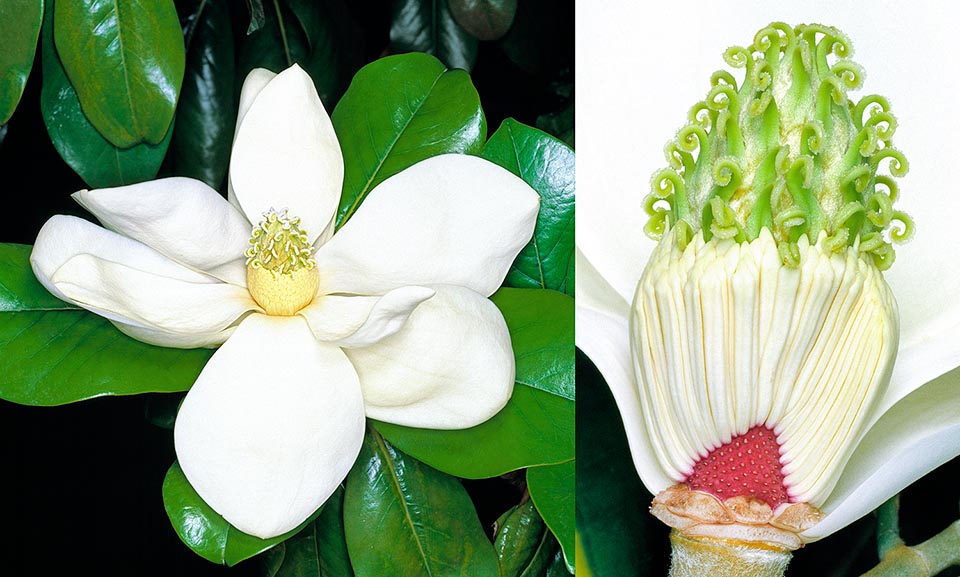
Magnolia grandiflora. The family Magnoliaceae unites more than 300 woody deciduous or evergreen species and shows several primitivity characteristics. Right, flower close-up: on the floral peduncle we see the free petaloid tepals (partly removed), the stamens partly show the red receptacle and above the carpels with green rounded stigmas. The Magnoliaceae usually have bisexual protogynous flowers with stigmas ripening before the anthers to favour the crossed pollination © Giuseppe Mazza
The Magnoliaceae family owes its name to the genus Magnolia assigned by Charles Plumier (1646-1704), in 1703, to a plant he collected on the island of Martinique and dedicated to Pierre Magnol (Montpellier, 1638-1715), physician and botanist French, director of the botanical garden of Montpellier.
Methods of molecular dating indicate that the Magnoliaceae have originated in the Cretaceous, about 112-104 million of years ago. Fossil finds of flowers, fruits and seeds of the extinct genus Archaeanthus, found in Kansas (USA) Dakota Formation and in particular the observations of the anatomy of the pericarp, observed with the optical microscopy, with polarized light and with the electronic microscopy, suggest that this genus may be the direct ancestor of the Magnoliaceae. A further finding can be obtained by observing the four-lobed leaves, not too common in the flowering plants, of the genus Liriodendron, quite similar to those of the fossil genus Liriophyllum.
Also, fossil records show that Magnoliaceae originated on the North American plate (Greenland, Spitzbergen, Alaska) and from there they have migrated to Europe and to Asia. Later on, during the Eocene (55,8-33,9 million years ago), they became extinct in Europe (Yulania was still present less than 2 million of years ago) and in part of North America.
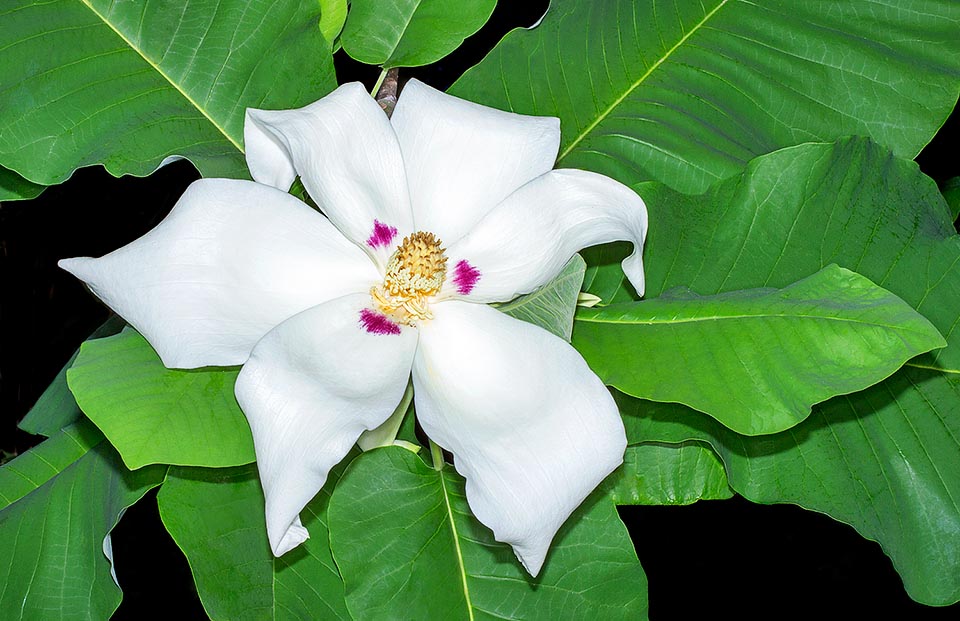
Magnolia macrophylla has up to 80 cm long leaves and solitary big flowers. Present in small USA areas and in Mexico, is under extinction risk in nature © Giuseppe Mazza
The late Mesozoic migration southwards of America and Asia and the reduction in the territories previously colonized, till the disappearance, due to the glaciations and partially to the continental drift, have caused the diversification of the southern species thus to form the present two separate distribution areas of the family, that, for the previously cited vicissitudes, are not the centre of origin.
Currently, two-thirds of the species in this family are found in temperate and tropical Asia up to New Guinea. The remaining species are found in America, from the eastern regions of North America, where they even colonize high altitudes, to the south of Brazil, although the number of species is increasing thanks to new studies. In fact, recent botanical explorations in Mexico, Central America, Ecuador and Peru have led to the discovery of new species, turning these territories into sites of high diversity, with several endemic species, due to the geographical isolation (allopatric speciation).
This proves that the Magnoliaceae, thanks to their adaptive capacity, have been able to colonize territories with very different climates, that is from cold to very hot and vice versa. The present deciduous temperate species come, in fact, from evergreen ancestors of the warm-temperate areas of eastern Himalaya.
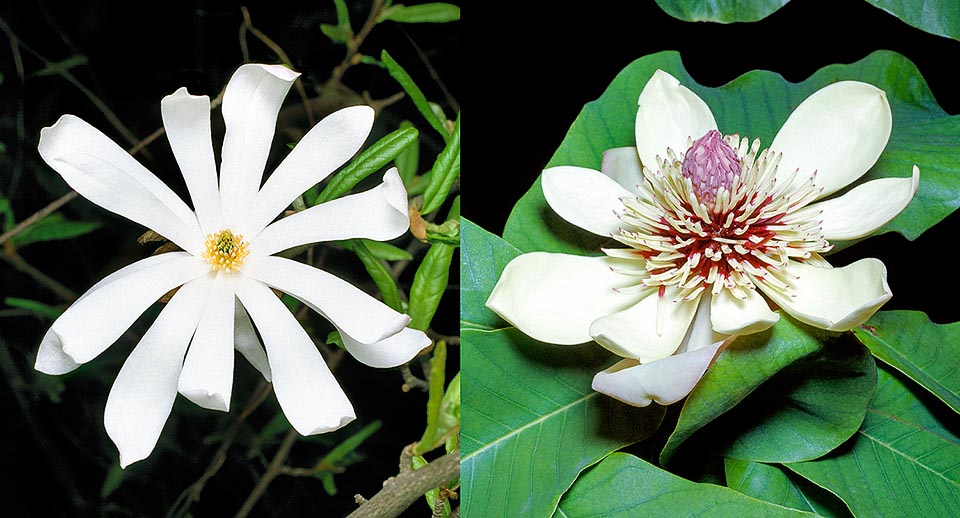
Magnolia stellata and Magnolia obovata. Fossil finds prove that Magnoliaceae are native to North America and through Europe migrating reached Asia, due to the late Mesozoic climate changes, to South America and Asia. Disappeared in Europe due to glaciations, thanks to their adaptability have colonized areas with quite different climates, tropical included. In North America today they also challenge the harsh alpine climates with presences up to 3400 m of altitude © Giuseppe Mazza
The family Magnoliaceae gathers more than 300 deciduous evergreen woody species, and presents various characters of primitivity. The vegetative apparatus has monopodial (that is, with only main axis) growth, or sympodial (with many branches lateral to the main axis) and presents the trunk characterized by conductive elements of wood (tracheae or tracheids) with dottings similar to those of the Conifers.
The leaves are simple, medium-large, whole or 2-10 lobate, spirally arranged, persistent or deciduous, with big stipules. The foliar margin is entire (lobate in Liriodendron) normally glaucous below.
The flowers are eye-catching, with radiated symmetry, bisexual, rarely monosexual, termonal or pseudo-axillary on a short axillar branch (brachioblast) with one or more deciduous bracts. The external involucre of the flower (perigone) is formed by 6-18 petaloid tepals, deciduous, free, mainly spirally arranged.
The flowers of the Magnoliaceae are big and robust because, having evolved before the hymenopterans appearance, are pollinated by the coleoptera. These visit the flowers to nourish (pollen), to mate and to get shelter, thanks to the comfortable temperature they find there.
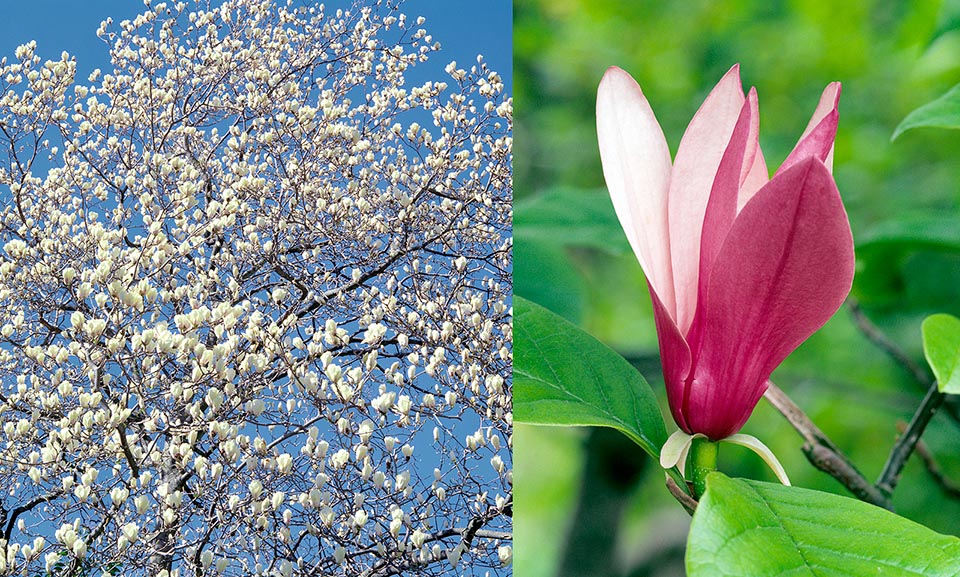
The Magnolia x soulangeana, created in 1820 by French gardener Etienne Soulange-Bodin crossing Magnolia denudata and Magnolia liliiflora, is a small tree with deciduous leaves and big early white and pink to violet flowers. Much appreciated in the horticultural environment, it has more than one hundred varieties good also for small gardens © Giuseppe Mazza
The stigmas ripen before the anthers (the flowers are protogynous). The stamens are numerous, free, spiralled on both sides of the receptacle, and the anthers are dehiscent longitudinally. The carpels (modified leaves producing the ovules) are numerous, 20-200, apocarpous or syncarpic, spiralled. The gynoecium, usually is sessile, with carpels free one from the other, spirally arranged over the receptacle, cone-shaped. The ovules are numerous, rarely reduced to one.
The fruits are dry, dehiscent by means of a fissure of the carpel (follicles), (indehiscent in Liriodendron). The seeds are one or more per carpel, big, with lively colours, (but Liriodendron), drooping in the dehiscent carpels. Their dispersion is done by the birds (ornithocory dispersion). The family is characterized by small chromosomes, with number base x = 19. The species of the temperate zones are polyploid.
The family Magnoliaceae has been considered primitive because of the leaves that are simple in an alternate spiral disposition, the flowers with numerous indistinguishable elements symmetrically radiated, also spirally arranged, the carpels are arranged in a cone of the receptacle forming an infructescence very similar to the fossil finds dated over 100 million of years ago.
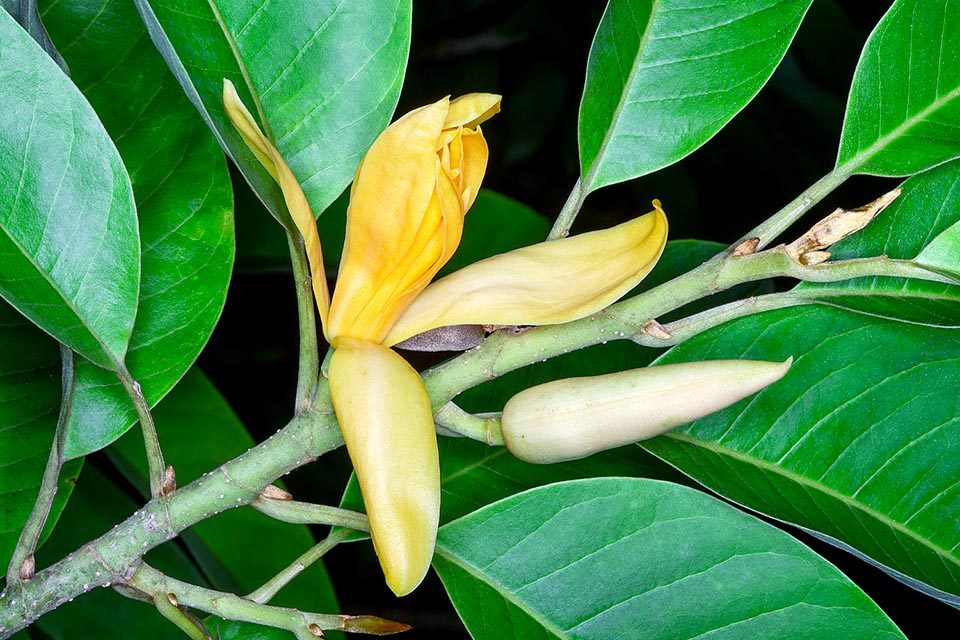
Magnolia champaca is native to South-east Asian mountains. Very scented flowers. the prized wood is used in cabinetry © Giuseppe Mazza
The systematics of the family has changed during the years and is still very discussed. Some authors assign 12 genera to the family, others divide the family in two subfamilies: Magnolioideae with the genera Dugandiodendron, Magnolia, Michelia, Champaca, Liriopsis, Talauma and Liriodendroideae with only one genus Liriodendron, others more, consider the genus Liriodendron as standing alone, and the genus Magnolia, paraphyleptic, with genera Alcimandra, Aromadendron, Dugandiodendron, Manglietiastrum, Parakmeria and Talauma. The genus Michelia includes Paramichelia and Tsoongiodendron. The basal branch of the phylogenetic tree of genus Magnolia is Talauma, that could keep its generic status, but not all botanists are in agreement.
The Magnolia Society International divides the genus Magnolia in three subgenera and 12 sections: 1) subgenus Magnolia, with the sections Magnolia, Gwillimia, Talauma, Mangletia, Kmeria, Rytidospermum, Auriculata, Macrophylla; 2) the subgenus Yulania, with the sections Yulania and Michelia; 3) the subgenus Gynopodium, with the sections Gynopodium and Mangletiastrum.
In this treatise we prefer to stick to what stated by “The Plant List” (2020) that assigns to this family the following taxonomically settled genera: Liriodendron, Yulania, Dugandiodendron, Magnolia, Michelia, Sphaerostema, Talauma.
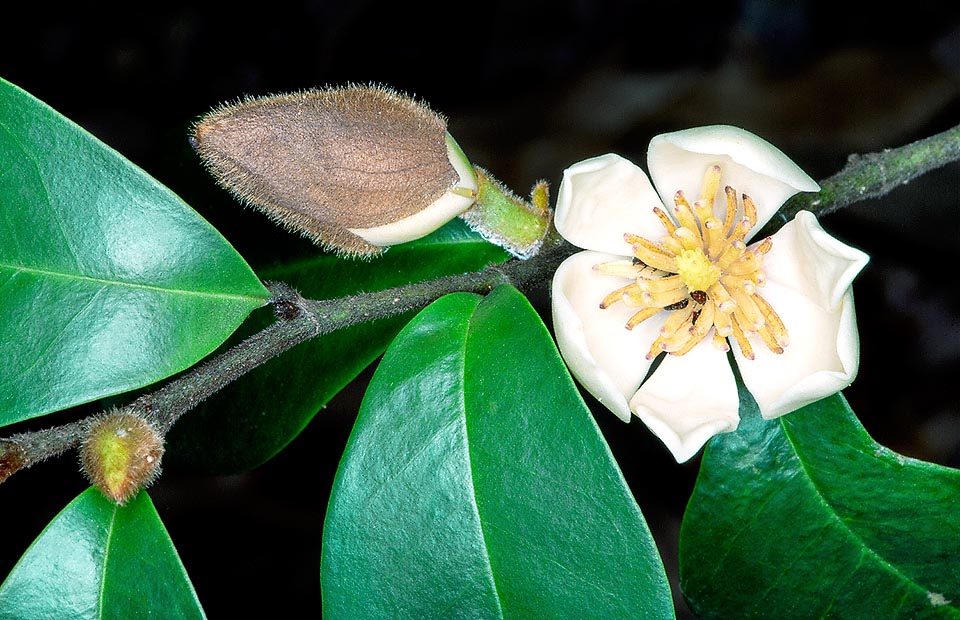
Magnolia figo tepals develop inside odd brown bracts. The about 4 cm broad flowers emit an intense scent of banana © Giuseppe Mazza
Several species of this family are utilized as timber for houses construction, and as wood for carpentry, cabinet making, beams and floors or as kitchenware. Magnolia striatifolia Little has a not too hard wood, with white sapwood and green-grey-yellowish heart. Magnolia officinalis Rehder & E.H.Wilson and M. champaca (L.) Baill. ex Pierre produce on the bark substances utilized in traditional and modern pharmacopoeia.
The bark of Magnolia mexicana DC., since the XVI century, has been utilized to stimulate the nervous system, to strengthen the heart, the stomach and to control female infertility. The bark of Magnolia grandiflora has tonic and febrifuge properties and has an inhibitory effect on the formation of melanin blocking the melanoma cancer cells. From the flowers of M. champaca are extracted essential oils, used in the cosmetic industry, for the production of perfumes and in the herbal field, as painkillers, anti-inflammatory, to treat headache, anxiety, stress and rheumatisms. The leaves of Magnolia obovata Thunb. have antimicrobial and antioxidant activity.
Many are the magnolias cultivated also for the beauty of the flowers and for their posture. Chinese, since the VII century, did cultivate Magnolia denudata Desr. in the gardens of the temples because they considered it a symbol of purity. The flowers of M. champaca were carried in the temples and the women did utilize them as a garment of their hairs.
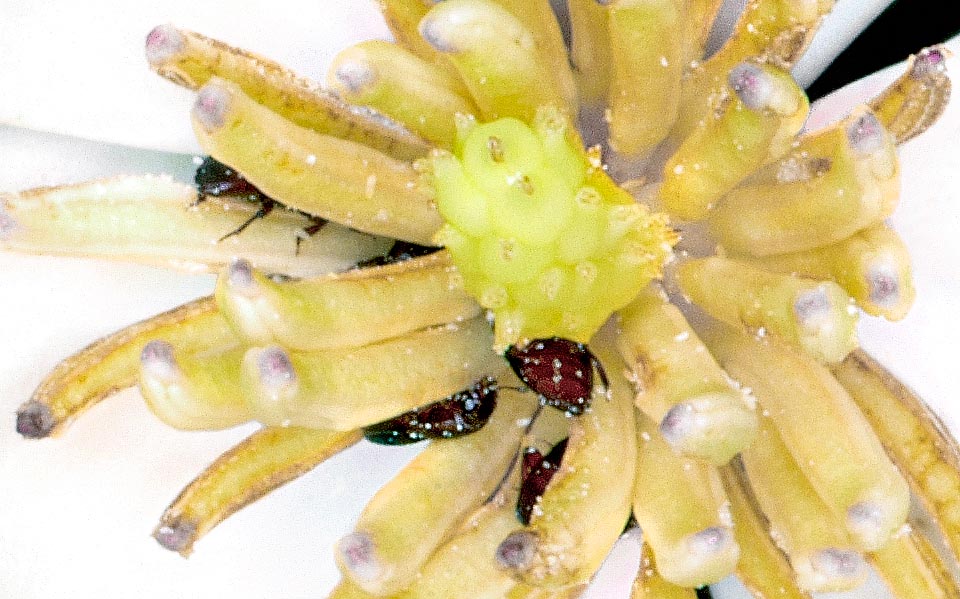
Very enlarged close-up of Magnolia figo previous image to better show the small pronubial insects hidden among the growing stamens. Magnoliaceae have evolved long before the appearance of hymenopterans and still now are pollinated by coleopterans that eat pollen and find among stamens a friendly and warm shelter to reproduce © Giuseppe Mazza
In the parks and in the gardens are cultivated various species, such as the aforementioned M. grandiflora, characterized by solitary flowers, large, white and very perfumed; M. stellata native to Japan, with white flowers, perfumed, and deciduous leaves of glossy green colour, yellow-bronze in autumn; M. glauca native to America with tulip-shaped flowers of white cream colour, perfumed.
Very diffused in Europe and in the USA, is the interspecific hybrid Magnolia × soulangeana created in 1820 by the French gardener Étienne Soulange-Bodin crossing Magnolia denudata Desr. with Magnolia liliiflora Desr. It is a small tree with deciduous leaves and early and large flowers, of variable colour, from white, pink to violet. Of this are known and cultivated more than one hundred varieties.
Magnolia figo (Lour.) DC is cultivated in the gardens due to its fragrant flowers (‘banana shrub’ because of its characteristic banana scent) of about 4 cm of diametre and for the coriaceous and glossy leaves, 8-12 cm long.
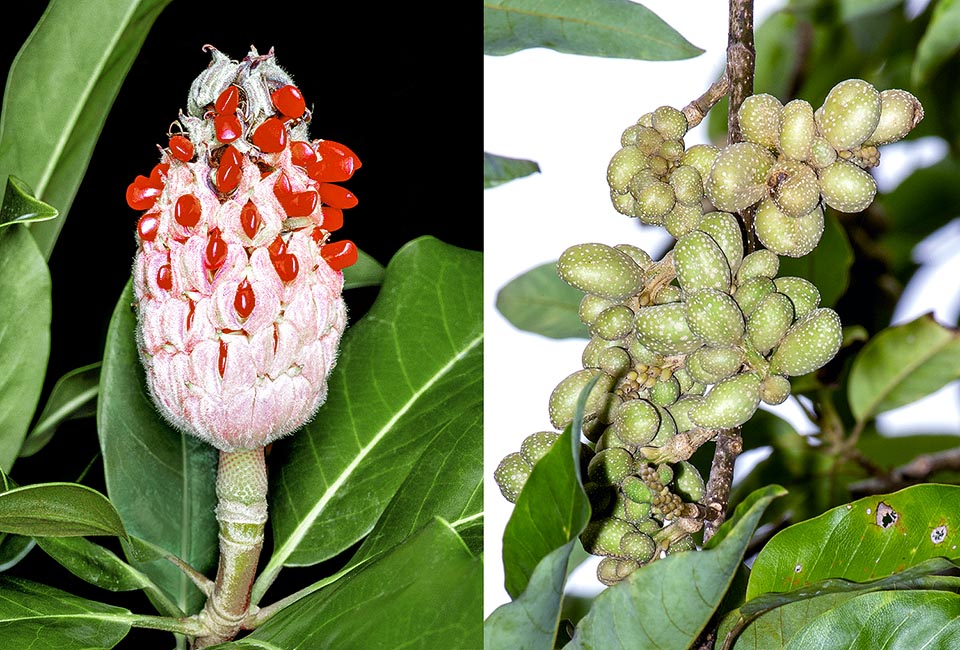
On the left in the picture, the well-known infructescence of the Magnolia grandiflora infructescence. It presents like a cone, surely a fashion form, when the earth was ruled by the conifers. It’s erect, conical, brownish when ripe, with reddish seeds. Then hanging and held by a capillary cord called funiculus. Right, Magnolia champaca growing fruits, carried on a spirally drooping cluster. Each fruit when ripe opens and shows inside 2-6 red or pink seeds also hanging linked to a funicular cord © Giuseppe Mazza
Magnolia kobus DC is a shrub with deciduous leaf, rather rustic, with oval leaves, up to 15 cm long and the white flowers, often with shades of pink, that appear in spring before the leaves. The seeds form in clusters, opening in autumn attracting the birds with their red colour.
Magnolia virginiana L. is an ornamental tree cultivated in the gardens due to its eye-catching and scented flowers, its attractive foliage and its fast growth. The species, initially known as Magnolia glauca (L.) L., was the first one to be introduced in Europe thanks to the English botanist and missionary John Baptist Banister (1654-1692) who, having collected it in 1678 in Virginia (USA), sent it to the Bishop of London, Henry Compton (1632-1713).
Magnolia macrophylla Michx., of south-eastern USA and of eastern Mexico, has been introduced in Europe in 1800. It’s a very particular plant due to the big dimensions of its leaves (up to 80 cm long and upto 30 cm broad) and the isolated flowers, also very big. Due to the unlawful collection of the species, which has a small distribution area, it risks extinction in nature.
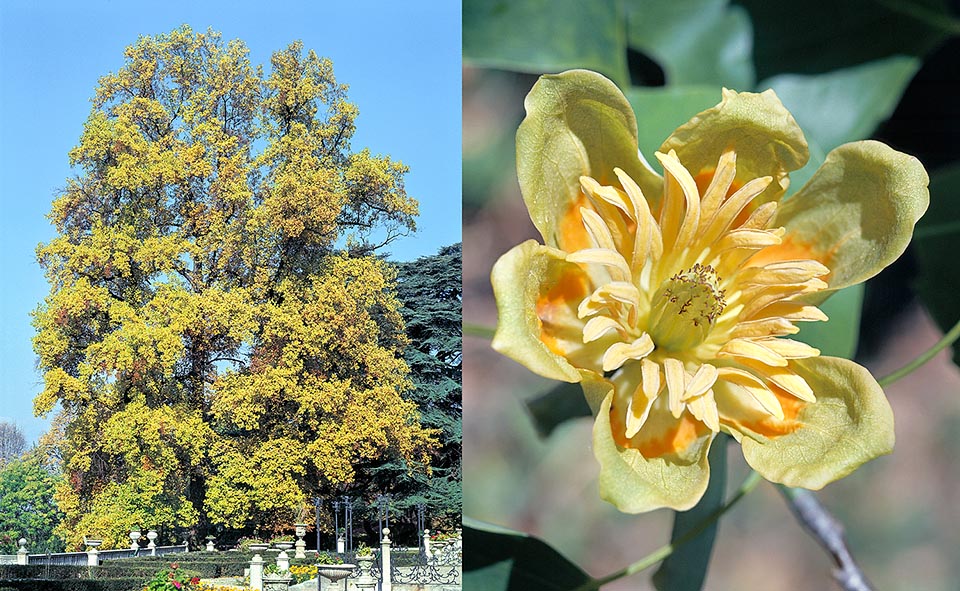
Liriodendron tulipifera is a very cultivated tree due to its elegant posture. In late spring produces erect inflorescences, with tulip-shaped flowers © Giuseppe Mazza
In Italy, in particular in the central-northern regions, is very diffused in cultivation. The Tulip tree (Liriodendron tulipifera L.) due to its elegant posture and the flowers looking like tulips. In the park of Villa Besana in Sirtori (Lecco), are present eight specimens of L. tulipifera and one of these, with its height of 52 m and 5 m of circumference, as certified by the State Forestry Corps, can be assumed to be one of the tallest trees in Italy. Other species of great impact in the gardens is the Magnolia obovata Thunb due to its red-violaceous flowers externally and almost white inside forming in early spring, just before the leaves.
In nature, the overexploitation for the timber and the medicinal use of the Magnoliaceae, with consequent destruction of the habitats, are matter of serious concern for their survival. After the red list of the IUCN (The International Union for Conservation of Nature’s Red List of Threatened Species) many are the species of the family Magnoliaceae with risk of extinction. The rulers should take in serious consideration the studies of this international organization and put in place all necessary actions of conservation and of protection.
→ To appreciate the biodiversity within MAGNOLIACEAE family please click here.
